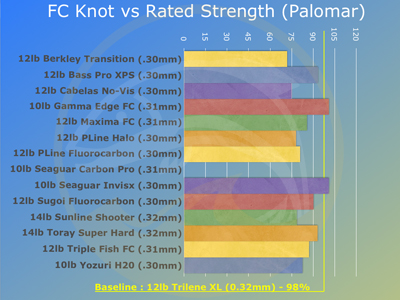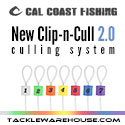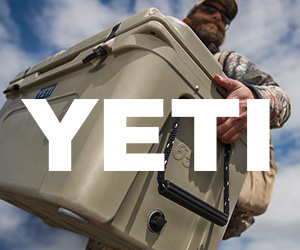Presenting the Much Anticipated and Highly Overdue TackleTour Fluorocarbon Showdown!! (continued)

 Knot Strength: Perhaps even more vital than the tensile test data is actual knot strength of fluorocarbon lines. This opens up the debate of which knot is best to tie with fluorocarbons. For years we've heard the one knot you do not want to use with FC lines is the palomar. In other circles you will hear discussions that the palomar is fine with good fluorocarbon lines, but not the poorly made ones. With such controversey surrounding this one knot, we decided to investigate head on and employ the palomar for our tests. The best way to set up the comparison? Why of course, testing the palomar knot first, with our baseline 12lb Trilene XL where we recorded, on average, knot failure at 11.8 pounds of pressure.
Knot Strength: Perhaps even more vital than the tensile test data is actual knot strength of fluorocarbon lines. This opens up the debate of which knot is best to tie with fluorocarbons. For years we've heard the one knot you do not want to use with FC lines is the palomar. In other circles you will hear discussions that the palomar is fine with good fluorocarbon lines, but not the poorly made ones. With such controversey surrounding this one knot, we decided to investigate head on and employ the palomar for our tests. The best way to set up the comparison? Why of course, testing the palomar knot first, with our baseline 12lb Trilene XL where we recorded, on average, knot failure at 11.8 pounds of pressure.

We tested each lines' knot strength and compared it against its rated strength...
KS vs Rated Strength: Comparing knot strength to actual, rated strength with our Trilene XL reveals a 98% value. Using this comparison with our entire test lot, revealed only five out of our fourteen test subjects recorded average breaking strengths of ninety percent or more. In fact, two recorded values below 80%. One of our lines, Seaguar Carbon Pro, was absent from this test all together as we ran out of line by the time we reached this segment of our tests.

...and it's actual tested strength - Seaguar's InvisX and Sugoi's Fluorocarbon products fared the best in this analysis
KS vs Tested Strength: After all we've been through with these lines, just how good, really, is the data of knot strength versus rated strength? Wouldn't a more accurate portrayal pit each lines' knot strength against their actual, tested breaking strength? Indeed it would and when tallied against this data, all but one of our test subjects, including our baseline, fall below the 90% mark at knot strength. It seems, the general statement of fluorocarbons having poor knot strength is still up in the air. Many of our lines faired no worse than our baseline Trilene XL when submitted against actual tensile strength data. Moreover, perhaps this test really calls into question the strength of the palomar knot in general! So who fared best here? Seaguar's InvisX tested with a 92.7% knot strength versus tested strength ratio - an actual value of 10.1 pounds of knot strength versus its rated strength of 10 pounds and actual tested strength of 10.9.
|
TackleTour Fluorocarbon Showdown Knot Strength (KS) Data
|
|
Brand : Make
|
Rated Strength (lbs)
|
Knot Strength (lbs)
|
KS vs Rated Strength
|
KS vs Tested Strength
|
| Berkley : Vanish Transition |
12
|
8.6
|
72%
|
80.7%
|
| Bass Pro Shops : XPS FC |
12
|
11.2
|
93.4%
|
80%
|
| Cabelas : No-Vis FC |
12
|
9.0
|
75%
|
79%
|
| Gamma : Edge FC |
10
|
10.1
|
101%
|
72.2%
|
| Maxima : Fluorocarbon |
12
|
10.3
|
85.7%
|
62.4%
|
| P-Line : Fluorocarbon |
12
|
9.7
|
81.1%
|
81.8%
|
| P-Line : Halo |
12
|
9.4
|
78.1%
|
72.1%
|
| Seaguar : Carbon Pro |
10
|
--
|
--
|
--
|
| Seaguar : Invisx |
10
|
10.1
|
101%
|
92.7%
|
| Sugoi : Fluorocarbon |
12
|
10.8
|
90.3%
|
89.6%
|
| Sunline : Shooter FC |
14
|
11
|
78.7&
|
69.8%
|
| Toray : SuperHard |
14
|
13
|
93.2%
|
82.6%
|
| Triple Fish : Fluorocarbon |
12
|
10.5
|
87.3%
|
73.2%
|
| Yozuri H20 |
10
|
8.3
|
82.7%
|
70.1%
|
| Berkley : Trilene XL |
12
|
11.8
|
98%
|
82.2%
|
Conclusion: We know, we know, you want more. Like how about an actual winner? or How about an impact test? or How about the best knot to use with fluorocarbons? or How about memory? What was that again? oh yeah, memory... Our goal with this article was not a comprehensive test and winner take all comparison. Rather it was to build the foundation for a series of more intensive, individual on the water reviews where we hope to address the remaining issues for some, but perhaps not all, of the lines presented. In other words, consider this our fluorocarbon culling system. In these individual tests, we will look more closely at factors such as memory, handling, castability, and even that actual degree by which each line seems to be affected by water absorption - if at all. For now, realize that we were able to validate some myths (water absorption, abrasion resistance) debunk others (low stretch), and at least, call to question the claims of still more (poor knot strength) when compared against a popular and widely used monofilament like Berkley's Trilene XL. So stay tuned as we take some of these spools, order others, and line our reels enroute to restarting and renewing TackleTour's line review department. Until then, tight lines!























